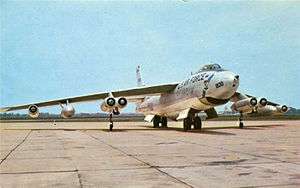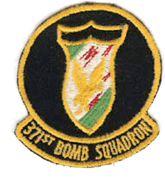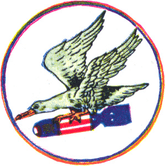371st Bombardment Squadron
The 371st Bombardment Squadron is an inactive United States Air Force unit. Its last assignment was with the 307th Bombardment Wing, based at Lincoln AFB, Nebraska. It was inactivated on 25 March 1965.
| 371st Bombardment Squadron | |
|---|---|
 B-47 Stratojet as flown by the squadron[note 1] | |
| Active | 1942–1946; 1946–1965 |
| Country | |
| Branch | |
| Role | Bombardment |
| Engagements | South Pacific Theater |
| Decorations | Distinguished Unit Citation Philippine Presidential Unit Citation Republic of Korea Presidential Unit Citation |
| Insignia | |
| Patch with 371st Bombardment Squadron emblem (approved 4 September 1956)[1] |  |
| 371st Bombardment Squadron emblem (World War II) |  |
History
Formed as a heavy bombardment group in January 1942, trained in the Pacific Northwest under Second Air Force, with B-17 Flying Fortresses. Reassigned to Seventh Air Force in Hawaii, November 1942 and performed performing search and rescue and antisubmarine patrols until January 1943 while transitioning to long-range B-24 Liberator heavy bombers.
Deployed to Central Pacific from Hawaii throughout 1943 for long-range combat bombardment operations against Japanese forces in the Central Pacific; New Guinea; Northern Solomon Islands and Eastern Mandates campaigns. Deployed to the New Hebrides in Melanesia and operated from numerous temporary jungle airfields, engaging in long-range bombardment operations during the Bismarck Archipelago; Western Pacific; Leyte; Luzon and Southern Philippines campaigns until the end of the war in August 1945. Assigned to Clark Field, Philippines after the war ended, demobilized with personnel returning to the United States, unit inactivated as paper unit in January 1946 in California.
Reactivated as B-29 Superfortress squadron at MacDill Field, Florida in August 1946 as part of Strategic Air Command. Was a training unit for antisubmarine warfare. Deployed to Okinawa during Korean War, carrying out combat operations over Korea throughout the conflict. Remained in Okinawa until November 1954 when inactivated. Reactivated simultaneously at Lincoln AFB, Nebraska, as a B-47 Stratojet medium jet bomber squadron, performed REFLEX deployments to North Africa until phaseout of B-47 in 1965 and inactivated.
Lineage
- Constituted as the 371st Bombardment Squadron (Heavy) on 28 January 1942
- Activated on 15 April 1942
- Redesignated 371st Bombardment Squadron, Heavy c. March 1944
- Inactivated on 18 January 1946
- Redesignated 371st Bombardment Squadron, Very Heavy on 15 July 1946
- Activated on 4 August 1946
- Redesignated 371st Bombardment Squadron, Medium on 28 May 1948
- Inactivated on 25 March 1965[2]
Assignments
- 307th Bombardment Group, 15 April 1942 – 18 January 1946
- 307th Bombardment Group, 4 August 1946 (attached to 307th Bombardment Wing after 14 February 1951)
- 307th Bombardment Wing, 16 June 1952 – 25 March 1965[2]
Stations
|
|
Aircraft
- Boeing B-17 Flying Fortress, 1942
- Consolidated B-24 Liberator, 1942–1945
- Boeing B-29 Superfortress, 1946–1954
- Boeing B-47 Stratojet, 1955–1965[2]
References
Notes
- Explanatory notes
- Aircraft is Lockheed Marietta built Boeing B-47E Stratojet, serial 53-1830, taken at Langley AFB.
- Citations
- Maurer, Combat Squadrons, pp. 459-460
- Lineage information, including aircraft, assignments and stations, through March 1953 in Maurer, Combat Squadrons, pp. 459-460
Bibliography
![]()
- Maurer, Maurer, ed. (1983) [1961]. Air Force Combat Units of World War II (PDF) (reprint ed.). Washington, DC: Office of Air Force History. ISBN 0-912799-02-1. LCCN 61060979. Retrieved 17 December 2016.
- Maurer, Maurer, ed. (1982) [1969]. Combat Squadrons of the Air Force, World War II (PDF) (reprint ed.). Washington, DC: Office of Air Force History. ISBN 0-405-12194-6. LCCN 70605402. OCLC 72556. Retrieved 17 December 2016.
- Ravenstein, Charles A. (1984). Air Force Combat Wings, Lineage & Honors Histories 1947-1977 (PDF). Washington, DC: Office of Air Force History. ISBN 0-912799-12-9. Retrieved 17 December 2016.